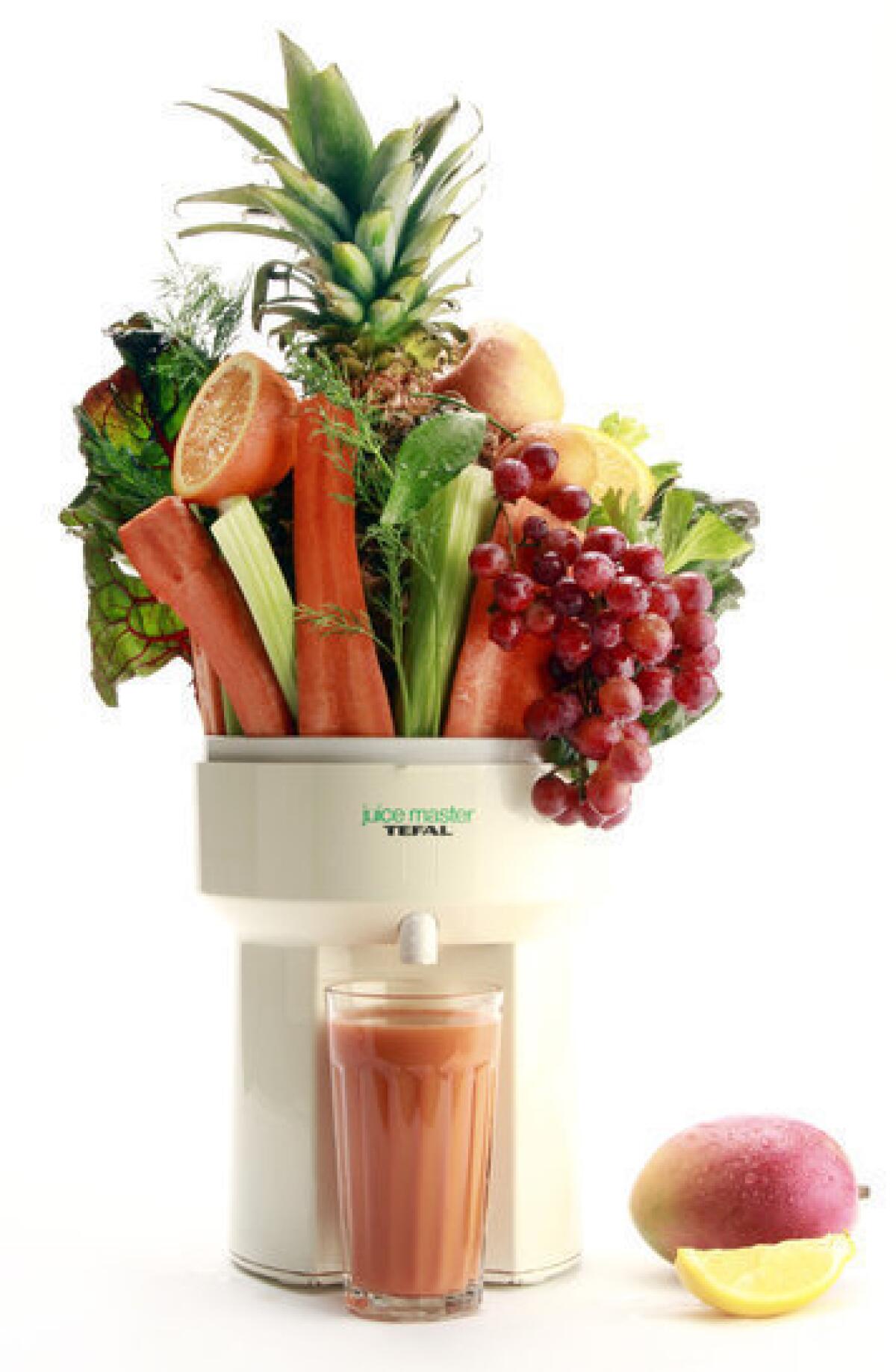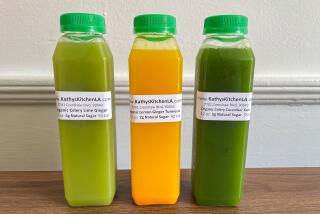Brave new whirl: Juices can pack power, and so can the machines that make them

- Share via
Not so long ago, people made juice by squeezing oranges on a little cone-shaped tool. How quaint, compared with the machines and shops and ingredients that are part of the world of juicing.
“It’s becoming part of the culture,” said Dr. Frank Lipman, who incorporates holistic medicine in his New York practice. “Juicing is a quick way to get a boost.”
That might sound odd to the millions of people who have a glass of fruit juice each morning with their cereal or toast. But the sorts of juices that are gaining cachet these days are distant relatives to the cartons of apple or orange juice on many supermarket shelves.
These new wave juices often contain an assortment of whole fruits and vegetables — often the ones that health authorities suggest people consume more of, like kale and chard. They get sweetness from apples and unusual flavors from ginger, cayenne or turmeric. And while some people are devoted to near-fasts based on juices, for many others, juice is just delicious.
Sales of home juicers are up: According to market research firm the NPD Group, consumers spent $207 million on juicers in the year ending last October, up 37.2% from the preceding 12 months. Shops specializing in organic fresh juices are popping up everywhere, many offering delivery.
Despite the trend, however, people who want to start juicing “need to navigate their way through it,” said nutritionist Tricia Williams, who said that eating whole fruits and vegetables is still key.
“That said, juicing works well as a supplement,” she said. “But if people are going to add juices, especially fruit-based, they need to remove the fruit from elsewhere in their diet.” She cautioned that juices can still be overloaded with sugar and calories; a 12-ounce serving of all greens contains 150 calories, but that number climbs steeply once you start adding apples, carrots, beets and other produce high in natural sugar.
Juicing at home
With juices running as much as $12 a serving in specialty shops, devotees might invest in a juicer, which costs $35 to $2,500. A blender can work too, says Kelly Boyer, who founded the meal and juice delivery and catering company Paleta. She suggests adding ice during blending to keep the liquids cool.
Drew Canole, a former finance executive who wrote a book on juicing, says the choice of juicer depends on the type of produce being juiced: a masticating juicer has gears that grind at a slow speed and are better for leafy greens, while a centrifugal one has a fast-spinning head that works best for carrots, beets and apples. Professionals and serious juicing amateurs use presses, which tend to be the most expensive, are durable and make juices that stay fresh longest, Canole said.
Popular new machines include the $100 NutriBullet, a space-efficient unit with a 600-watt motor that keeps the produce fiber intact. (Most juicers do not.) Some liquid, such as water, coconut water, lemon or lime juice, must be processed with the greens and fruit.
Pitched toward the novice is Black & Decker’s Juice Extractor, $34.99, a centrifugal juicer mostly for non-leafy greens, while well-known brands like Omega offer numerous options in both centrifugal and masticating versions, priced from $200 to $380.
Ray Doustdar, an entertainment industry executive, is convinced. He started juicing when his cholesterol was too high, and he said changing his diet reduced his level to a normal range in four months. “The biggest thing I hear is that juicing is hard, the clean-up is cumbersome, people don’t have the time. But I can show it can be done in 10 minutes,” Doustdar said.
Making, drinking juice
Consumers who are new to juicing should devise concoctions that are at least 80% vegetables to keep the sugar down, Lipman says. Start with cucumber and celery before adding chlorophyll-rich kale and other dark greens, he says. Other good juice ingredients include parsley, spinach and romaine lettuce. The vegetables provide the biggest nutritional punch, and the fruit makes the drink sweet and more palatable.
Even then, Lipman said, don’t overdo it. “One juice every second day is a good way to start,” he said.
“Greens mixed with apple, pear or berries are a great way to start the day,” Boyer said. “Ginger is good for flavor and the tummy. People should experiment to find something that tastes good. It needs to be yummy — not like you’re taking your medicine for the day.”





